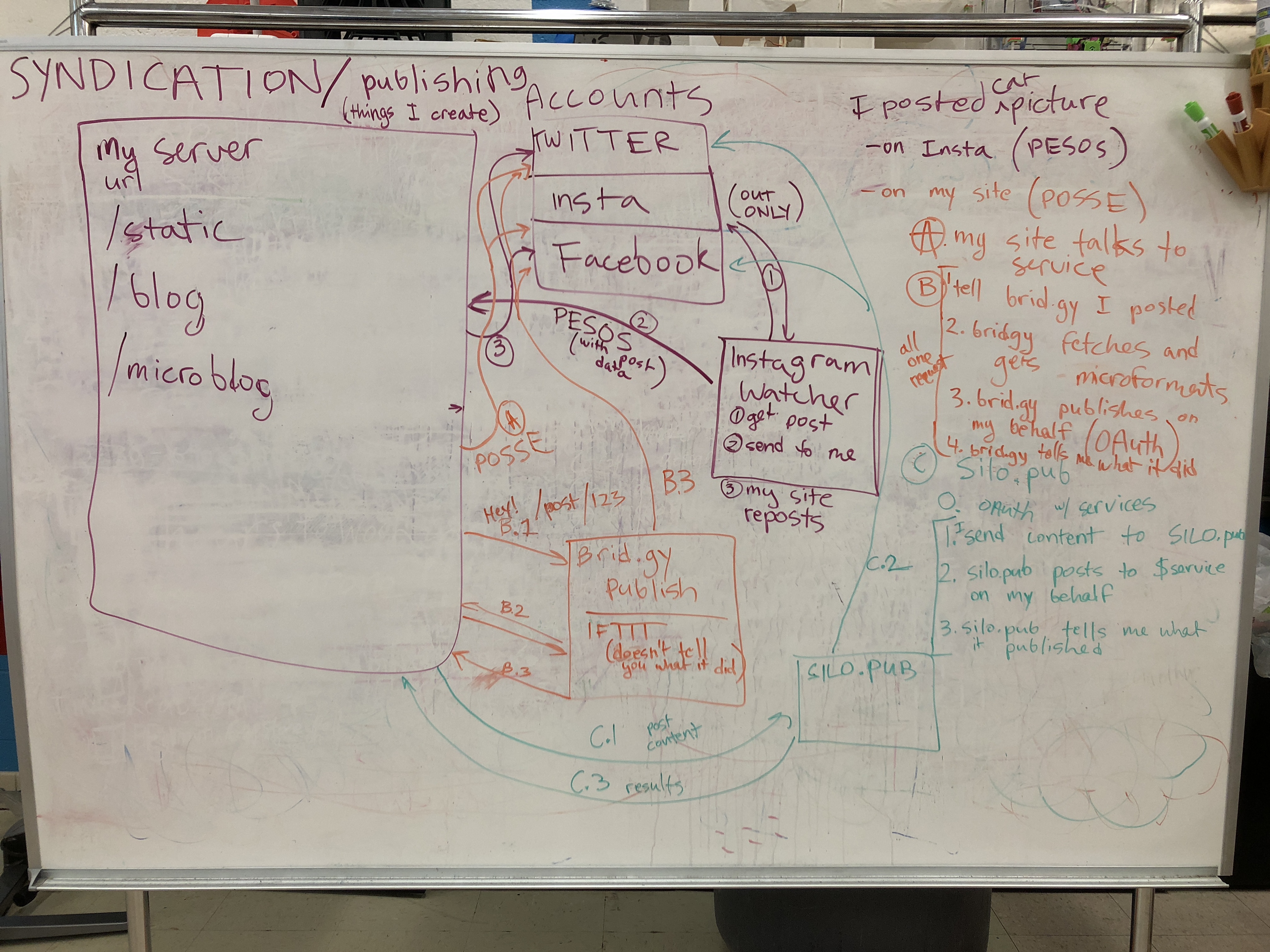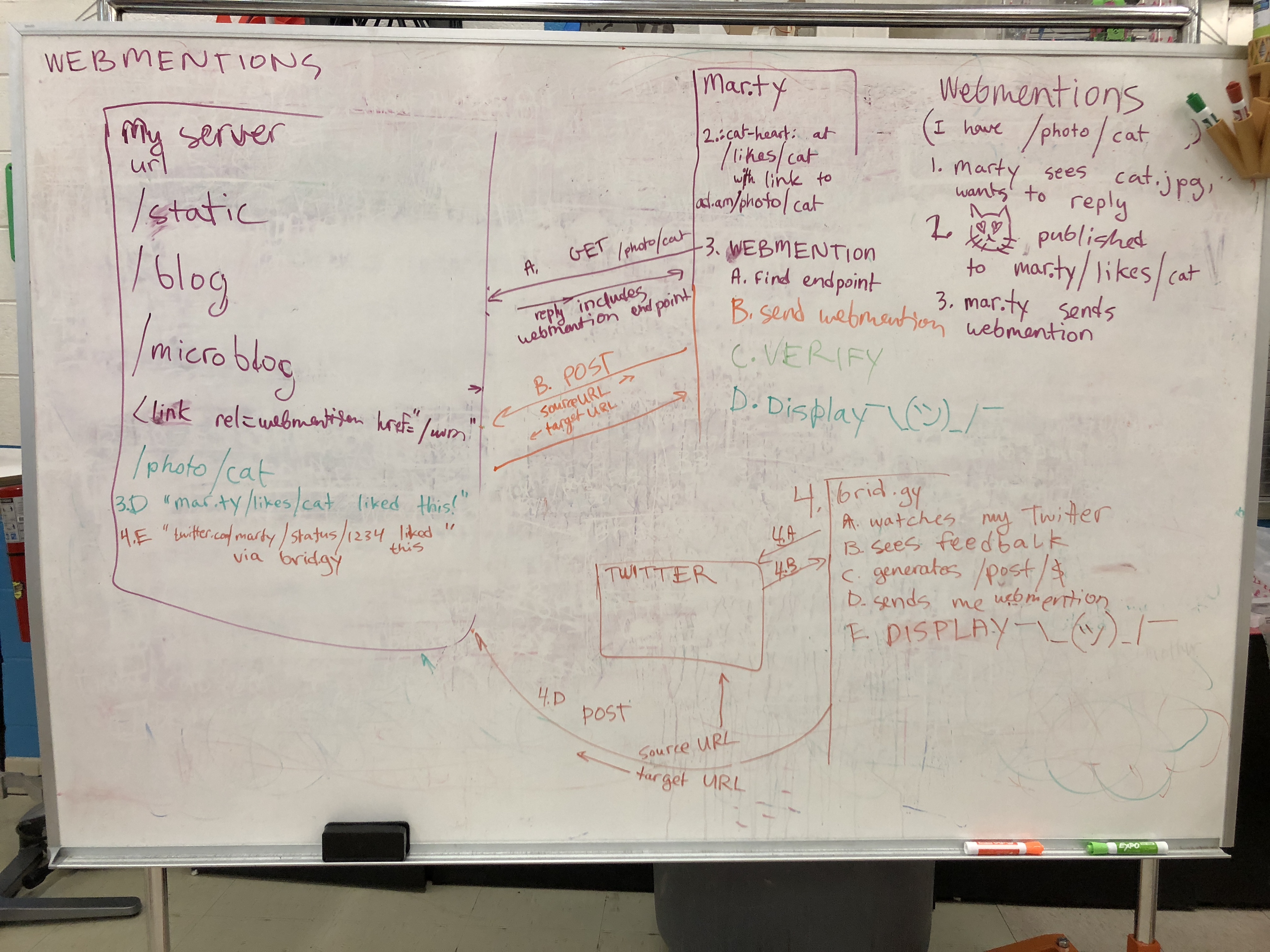2018/Baltimore/showmeindie
Building Blocks (draw it/diagram it) was a session at IndieWebCamp Baltimore 2018.
Video: https://www.youtube.com/watch?v=h5_lRiQZZsY
Notes archived from: https://etherpad.indieweb.org/showmeindie
IndieWebCamp Baltimore 2018
Session: Building Blocks, Visually, Diagrammy (#showmeindie)
When: 2018-01-20 14:10
Participants
- adambachman.org (facilitator)
 Aaron Parecki
Aaron Parecki- Matt
- Lydia
- arturpaikin.com
 Marty McGuire
Marty McGuire- ... add names
Notes
We'd like to visualize what servers/services play a part in the IndieWeb, what data they hold, what protocols they use to move which data around.
My Accounts
My Site
- on a server
- has a URL
- some static content (e.g. /static)
- some dynamic content (e.g. /blog, maybe in a database)
- an example post /microblog
- stored in my server
- how does it get to Twitter? Or others? Many possibilities.
Do we want to always POSSE everywhere? Sometimes now.
Example case: "I post a cat picture for all three silos".
Starting with: "i posted a picture post to my site, pointing to an image called picture.jpg"
- there's a wrench in the system already, because Instagram has no API to post images *to* Instagram.
- but it *can* go the other way:
- a "thing" (Instawatcher™) watches your instagram feed
- we think of it as a black box because there are many ways to scrape your instagram and it really doesn't matter how you get the new post data as long as you get it.
- it knows how to add posts to your website. there are many ways to do that, but micropub is the most common among indieweb folks.
- this is PESOS - publish elsewhere, syndicate to your own site
- a "thing" (Instawatcher™) watches your instagram feed
- but it *can* go the other way:
Twitter and Facebook both have posting APIs. Once that new photo post arrives at your website, they can be copied to those silos.
- this is the POSSE model - publish on your own site, syndicate elsewhere
- there are several ways this could happen.
- your site could use Twitter and FB APIs directly
- an external service can watch your site grab the new content, and make platform-native API calls to syndicate that post. (e.g. IFTTT, bridgy publish)
- "hey bridgy, i posted this URL"
- bridgy fetches that URL and parses content using microformats
- bridgy has oauth tokens for your Twitter, Facebook account because you did the login dance there, so it uses platform-native API calls to post that content on your behalf.
- silo.pub is an API service that takes micropub requests and makes platform-native API calls
- you oauth it so it has a token for your Twitter, FB, whatever.
- you oauth your site's server so it has tokens to silo.pub
- each of your accounts is a different silo.pub identity
- your server sends a micropub request for each silo where you want the post to appear
A new building block came up: "posts elsewhere", aka the syndication links. These are the links to the post on each silo that corresponds to the "original" on your website.
- the instagram poster is going to give your site that URL directly because that's where the post came from originally
- bridgy publish will make the silo post and then give you back the URL of the new post on Twitter or FB
- silo.pub returns the URL to the syndicated post as part of the micropub
photo of the whiteboard: 
^^^ That's publishing. Let's talk responses, now.
I have my site on a server, with a cat photo post, which has a URL like /cat-photo
- Marty sees this post and wants to reply with 😻. He makes a "reply" post on his own site /marty-likes-cat-photo with "😻" content, and a link to /cat-photo
- Marty sends a webmention.
- First, he needs to know WHERE to send the webmention. He fetches /cat-photo and looks for a <link rel="webmention" href="/some-url-where-you-want-webmentions" />
- Once he knows that, he POSTs to /some-url-where-you-want-webmentions with:
- target=/cat-photo
- source=/marty-likes-cat-photo
My site will verify that webmention, but after that, it can do whatever it wants with that webmention!
- send me a notification to my phone
- display it on /cat-photo
- store it somewhere
- do nothing!
This now expands out to silos with a service like brid.gy
- brid.gy watches Twitter and Facebook and looks for posts that mention your post
- it creates a little proxy page about that post
- contains the actual details like "this post came from this URL and it's a like of your post"
- it sends you a webmention with that proxy page as a source
- your webmention handler should look in the microformats and find the canonical URL to make sure you're not linking back to bridgy's proxy.
- proxies like this could be used for spam, so source vs canonical URL should be flagged
photo of the whiteboard: 
